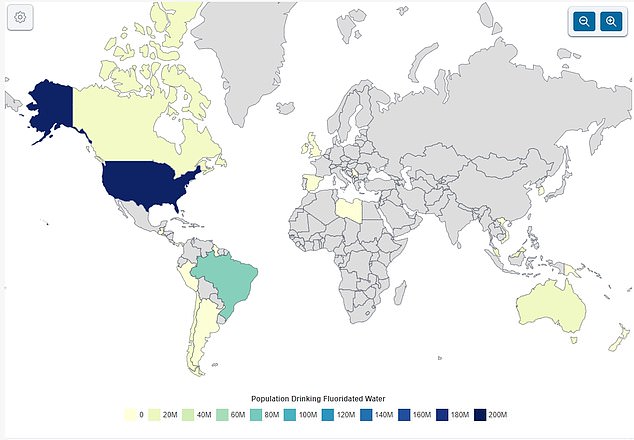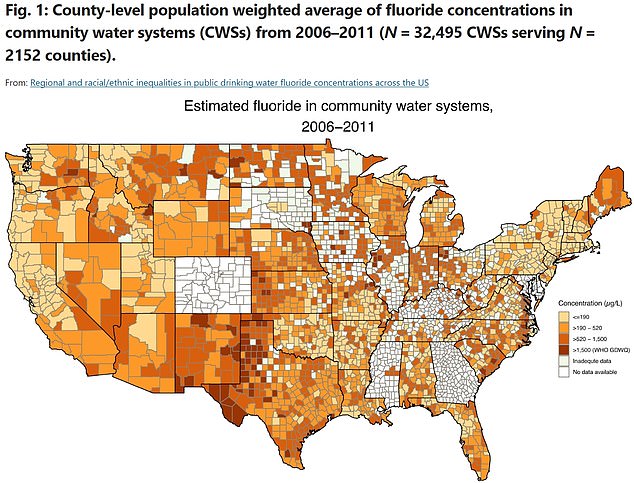Hundreds of thousands of American children are drinking tap water that could be lowering their IQ, according to a shocking government report.
The paper, described as the most comprehensive of its kind, concluded that consuming high levels of fluoride may harm brain development in children.
Researchers found that drinking water with more than 1.5 milligrams of fluoride per liter was associated with a drop in IQ of up to five points.
The finding could be significant, given that more than 1.9 million people rely on water systems with fluoride levels above 1.5 mg, the report said.
Based on an analysis of previously published research, the report marks the first time a federal agency has determined “with moderate confidence” that there is a link between fluoride and IQ.
The map above shows estimated fluoride concentrations in community water systems from 2006 to 2011. It was published in 2023. Counties that are in red have more than twice the recommended level of fluoride in their water.
Fluoride has been added to the U.S. water supply for decades after studies showed it could strengthen teeth and reduce cavities, in what has long been considered one of the greatest public health achievements of the 20th century.
Fluoridation is estimated to save $6.5 billion each year in dental treatment costs and reduce tooth decay by up to 25 percent, according to the CDC.
But the new report is likely to raise alarm bells in dozens of counties in Illinois, Texas and New Mexico, where research shows fluoride levels in water are particularly high.
Since 2015, the United States has recommended that fluoride levels in drinking water not exceed 0.7 milligrams per liter.
The Environmental Protection Agency says fluoride levels should not exceed four milligrams per liter to prevent skeletal fluorosis, a potentially crippling disorder that causes weaker bones, stiffness and pain.
And the World Health Organization says the safe limit is about 1.5 milligrams of fluoride per liter.
Experts say fluoride easily enters the blood when consumed and can then travel to the brain.
Previous animal studies have shown that fluoride can affect neurochemistry in areas of the brain linked to learning, memory, executive function, and behavior.
The new 324-page government report comes from the National Toxicology Program, part of the Department of Health and Human Services.
Some of the studies reviewed in the report suggested that IQ was 2 to 5 points lower in children who had had higher exposures.
The team did not reach a conclusion about the impact of fluoride at lower doses or its effect on adults.

There has been controversy over fluoride in the water supply for years, with hundreds of communities voting against its use (above is a campaign sign from Kennebunk, Maine).
The report adds to previous evidence suggesting that fluoride is linked to anxiety, mood problems and headaches in children as young as three years old.
And previous research suggested that pregnant women should limit their exposure to fluoride because the mineral can cross the placenta and reach the fetus.
The new report summarizes research from Canada, China, India, Iran, Pakistan and Mexico.
It was concluded that drinking water containing more than 1.5 milligrams of fluoride per liter was associated with lower IQ in children.
More than 1.9 million people — or 0.6 percent of the U.S. population — rely on water systems that contain natural levels of fluoride above 1.5 milligrams per liter, according to the report.
There was no mention of how many people use water systems with artificially added fluoride where concentrations are above this level.

The image above shows a woman filling a glass of tap water, amid concerns about the quality of tap water (file image)

This map, from 2020, shows fluoride levels in untreated groundwater supplies. Fluoride is a naturally occurring mineral that is often already present in many water supplies. Areas marked with a yellow or red dot have more than twice the recommended level of fluoride in groundwater.
Fluoride is a mineral found naturally in water and soil.
But about 80 years ago, scientists discovered that people who had a naturally more fluoride-rich water supply also had fewer cavities. They determined that fluoride replaced minerals that were lost in teeth due to decay and wear.
This sparked a campaign to get more Americans to use fluoride and to add the mineral to national drinking water supplies.
Today, approximately 70 percent of American households have access to fluoridated drinking water.
This figure is much higher than that of many comparable countries, including the United Kingdom (10 percent), Spain (10 percent) and Canada (40 percent).
The report comes as IQ scores in the United States are falling for the first time in a century.
A study by the University of Oregon and Northwestern University analyzed the results of nearly 400,000 IQ tests taken between 2006 and 2018, in a study published last year.
Although they did not give an exact drop, they said the biggest decline was among people aged 18 to 22 and those with lower levels of education.
The study only used data from before the Covid pandemic, meaning disruptions to education caused by lockdowns may have made the situation even worse.
According to the anti-fluoride group Fluoride Action Network, since 2010 more than 240 communities around the world have removed fluoride from their drinking water.
Regina Barrett, 69, from a small town in North Carolina, is among thousands of Americans who are unhappy with fluoride in their drinking water.
“Our water has been cloudy and bubbly and looks milky,” said Ms. Barrett, who blames fluoride for the problems, according to a statement. KFF Health News‘I don’t want fluoride in anything!’

More counties in the U.S. fluoridate their water than any other country in the world, data from the National Population Review for 2024 reveals
The National Toxicology Program began reviewing the impact of fluoride on drinking water in 2016.
There were earlier drafts, but the final report was repeatedly delayed. At one point, a committee of experts said that available research did not support the conclusion of an earlier draft.
The American Dental Association, which advocates for the use of fluoride in water, criticized earlier versions of the analysis but has not yet commented on the new report.
Rick Woychik, the program’s director, said in a statement: “Since fluoride is such an important issue for the public and public health officials, it was imperative that we do everything we could to get the science right.”
Official limits were initially set to prevent skeletal fluorosis, but increasing research points to a link between higher fluoride levels and an impact on brain development.
Researchers have wondered about the impact that ingesting water with infant formula might have on a developing fetus or very young child.
The Fluoride Action Network called this week’s report a “milestone” and said it proved what many researchers had long suspected.


